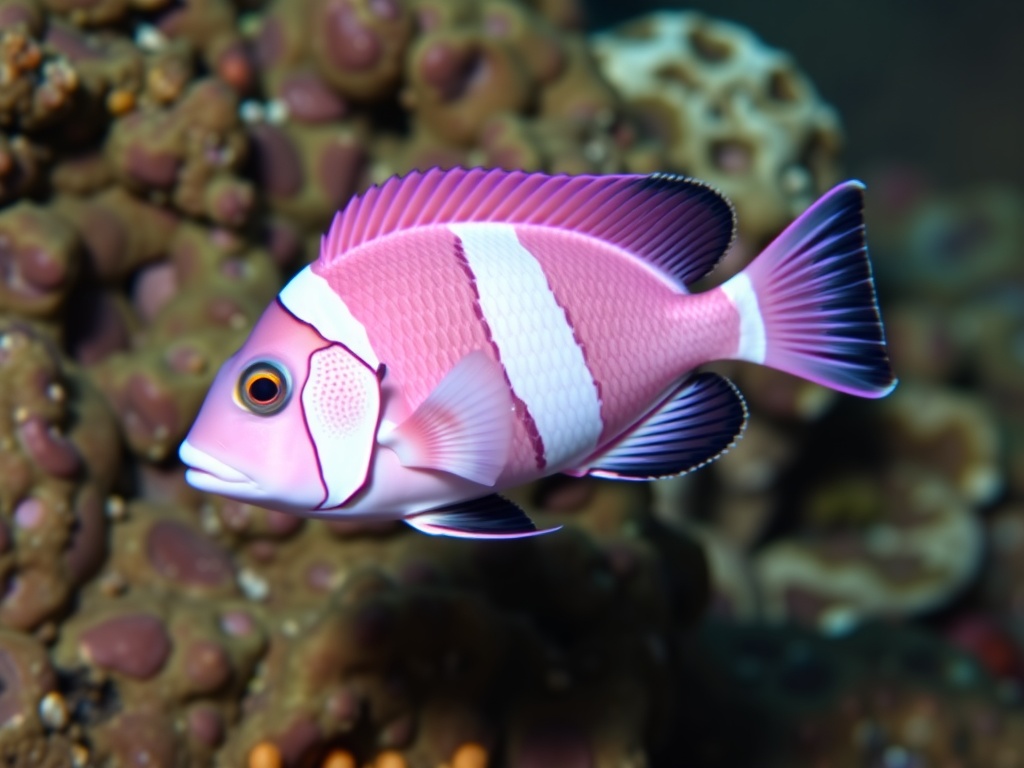
Peppermint Angelfish
Centropyge boylei

Meet the Peppermint Angelfish
The Peppermint Angelfish is a small, vividly colored marine fish, famed for its striking red and white vertical stripes that resemble peppermint candy. Native to the deep reef slopes of the central South Pacific, this elusive angelfish inhabits depths between 55 and 120 meters, making it difficult to observe or collect. Its diminutive size, brilliant coloration, and extreme rarity have made it highly sought after in the aquarium trade, often fetching enormous prices. Peppermint Angelfish are known for their shy and secretive nature, typically hiding among coral rubble and steep reef drop-offs.
Classification
Fish
Habitat
Deep coral reef slopes
Diet
Omnivore
Lifespan
5-10 years
Conservation
Data Deficient
Weight
10-18 grams
📖Fascinating Facts
Candy-like Appearance
The Peppermint Angelfish's red and white stripes closely resemble peppermint candy, hence its common name.
Deep Diver
This species inhabits depths often beyond typical recreational diving limits, usually between 55 and 120 meters, making it difficult and dangerous to collect.
Aquarium Rarity
Due to their scarcity, Peppermint Angelfish can fetch prices exceeding $30,000 USD in the aquarium trade.
📋Detailed Description
The Peppermint Angelfish (Centropyge boylei) is a diminutive marine angelfish, typically reaching a maximum standard length of approximately 7 cm (2.75 inches). Its body is laterally compressed and oval-shaped, with a relatively small mouth adapted for picking at tiny prey. The most striking feature is its coloration: five to six bold, vertical white stripes alternate with deep red to orange bands, running from the nape to the caudal peduncle, while the dorsal and anal fins are edged in white. The eyes are large and set high, likely an adaptation to the dimly lit depths it inhabits. This species is endemic to the deep outer reef slopes of Rarotonga in the Cook Islands, where it is associated with complex coral rubble and steep drop-offs between 55 and 120 meters. Peppermint Angelfish are highly secretive, spending much of their time sheltering in crevices and under overhangs, which offers protection from predators and strong currents. Their diet is omnivorous, consisting of benthic invertebrates, zooplankton, and filamentous algae, which they pick from the substrate. Socially, they are usually observed singly or in pairs, though small loose groups have occasionally been reported. Due to their deep habitat, little is known about their reproductive biology, but they are presumed to be protogynous hermaphrodites, like many other Centropyge species. Their rarity, combined with their vivid appearance, has made them one of the most coveted marine aquarium species, though their collection is limited by the technical challenges of deep diving.
💡 Did you know?
The first live specimen of the Peppermint Angelfish was only collected and photographed in 1990, making it a relatively recent discovery in marine biology.
🔬Research & Sources
🎭Behavior & Social Structure
Peppermint Angelfish are cryptic and reclusive, spending daylight hours hidden among coral rubble, caves, and overhangs to avoid predators. They exhibit crepuscular activity, emerging during dawn and dusk to forage. Feeding behavior involves picking at small crustaceans, worms, sponges, and algae growing on hard substrates. They are generally solitary but may form monogamous pairs, especially during the breeding season. Territoriality is observed, with individuals defending small home ranges against conspecifics. Their swimming is characterized by short, darting movements, allowing rapid retreat into shelter when threatened. They rely heavily on visual cues for navigation and foraging in the low-light environment of deep reefs.
👶Reproduction & Life Cycle
Direct observations of Centropyge boylei reproduction are lacking due to its inaccessible habitat, but reproductive behavior is inferred from closely related Centropyge species. They are believed to be protogynous hermaphrodites, with individuals starting life as females and some transitioning to males as they mature. Spawning likely occurs in pairs, with courtship involving circling and color displays. Fertilization is external, with eggs and sperm released into the water column during brief upward spawning rushes at dusk. The pelagic eggs hatch within 24-48 hours, and larvae remain planktonic for several weeks before settling onto the reef. No parental care is provided after spawning. Breeding seasonality is unknown but may be linked to lunar cycles or seasonal changes in water temperature and food availability.
🛡️Adaptations & Survival
Centropyge boylei exhibits several adaptations for deep reef life. Its large eyes enhance visual sensitivity in low-light conditions, while its vivid coloration may serve as camouflage among the red and orange hues of deep-water corals or as a warning to potential predators. The laterally compressed body allows maneuverability within narrow crevices. Its omnivorous diet and specialized mouthparts enable exploitation of a variety of food sources, including encrusting invertebrates and algae. Behavioral adaptations include extreme wariness and a tendency to remain close to shelter, reducing predation risk. Physiologically, it is adapted to withstand higher pressures and cooler temperatures found at depth.
📚Research Sources
🎨Cultural Significance
While the Peppermint Angelfish does not have a significant role in traditional Cook Islands culture or mythology, it has achieved iconic status among marine aquarists and collectors due to its beauty and rarity. Specimens have fetched prices exceeding $30,000 USD in the aquarium trade, making it one of the most expensive ornamental fish. Its allure has contributed to increased interest in deep reef biodiversity and conservation, highlighting the value of these poorly explored ecosystems.
🔬Recent Research & Discoveries
Recent advances in deep diving technology, such as mixed-gas rebreathers, have enabled limited scientific observation and collection of Centropyge boylei. Ongoing research focuses on its population density, habitat preferences, and genetic diversity, with the aim of informing conservation management. A 2022 study used environmental DNA (eDNA) sampling to detect its presence in unexplored reef areas, suggesting a potentially wider distribution than previously known. However, the species remains poorly studied, and further research is needed to clarify its life history, reproductive ecology, and response to environmental change.
🎥Wildlife Videos

Unveiling Rare Treasures: Secrets of the World’s Most Expensive Fish!
Ever wondered what makes some fish worth thousands of dollars? Discover the fascinating world of the most expensive fish on ...
Love Epic WildLife

The CANDY-Striped ANGEL - Peppermint Angelfish - Animal a Day Christmas Special
Today we learn about the fish that possessed a Christmas mint, the Peppermint Angelfish. Join this channel to get access to perks: ...
Animal a Day

LiveAquaria® Diver’s Den® Deep Dive: Peppermint Angelfish (Paracentropyge boylei)
Check out the newest episode of our Diver's Den® Deep Dive with Eric Radi. This episode showcases the "The Holy Grail" of ...
LiveAquaria

Rare Peppermint Angelfish The Most Expensive Aquarium Fish In The World
Dive into the enchanting world of the *Rare Peppermint Angelfish*, one of the most sought-after aquarium fish on the planet!
Kreature Planet

David Attenborough Presents: Hummingbirds - Jewelled Messengers | Free Documentary Nature
David Attenborough Presents: Hummingbirds - Jewelled Messengers | Nature Documentary Watch 'Birds of Passage - A Secret ...
Free Documentary - Nature

Angelfish Facts: fresh AND saltwater angelfish | Animal Fact Files
There are both freshwater and saltwater angelfish. This video focuses on both types to give a clear understanding of angelfish as ...
Animal Fact Files
🌍Habitat Information
The Peppermint Angelfish typically inhabits Deep coral reef slopes environments. Peppermint Angelfishs have adapted to their environments with specialized features and behaviors.
Primary Habitat:
Deep coral reef slopes
More detailed habitat information will be available soon.
🛡️Conservation Status
The Peppermint Angelfish is currently classified as Data Deficient. Conservation efforts are crucial for preserving this species for future generations.
Common Threats:
- 🏠Habitat loss and fragmentation
- 🌡️Climate change impacts
- 🎯Hunting and poaching
- 🏭Human-wildlife conflict
⚠️Threats & Conservation Challenges
The primary threats to the Peppermint Angelfish are overcollection for the aquarium trade and potential habitat degradation. Its restricted range and deep habitat make population assessments difficult, but its rarity in the wild suggests vulnerability to even low levels of exploitation. Deep reef habitats are also susceptible to damage from destructive fishing practices, climate change (e.g., ocean warming, acidification), and coral disease. The species' specialized habitat requirements and low reproductive output may further limit its resilience. Currently, it is classified as Data Deficient by the IUCN, reflecting the lack of comprehensive population data.
🔬Scientific Classification
Scientific Name
Centropyge boylei
Classification Hierarchy
🔍 About Taxonomic Classification
Taxonomic classification is a hierarchical system used by scientists to classify and organize living organisms based on shared characteristics and evolutionary relationships.
The system moves from broad categories (Kingdom) to increasingly specific ones, with each animal's scientific name typically consisting of its Genus and species.
📝Community Notes
Share your observations and insights about the Peppermint Angelfish with our community of wildlife enthusiasts.
Join Our Community
Sign in to share your observations and connect with fellow wildlife enthusiasts.
Sign In to ContributeNo community notes yet
Be the first to share your observations about the Peppermint Angelfish!
Explore Peppermint Angelfish
Select a tab above to learn more about this amazing animal.
📸Photo Gallery
No photos available for this animal yet.
🌟Discover More Wildlife
Continue your journey of discovery with more fascinating animals from our database
